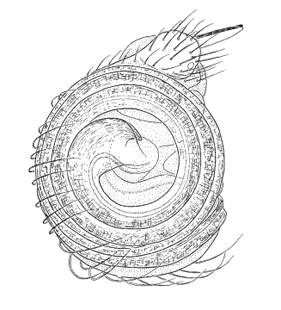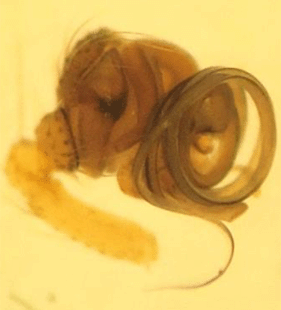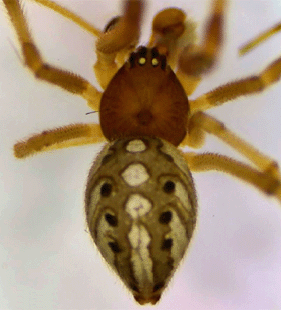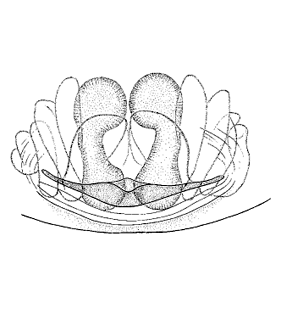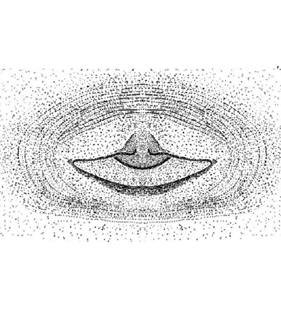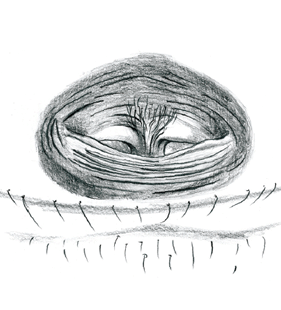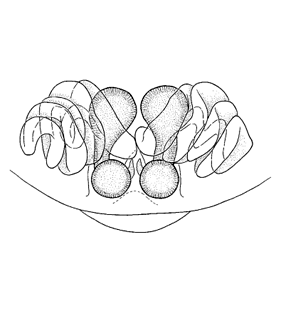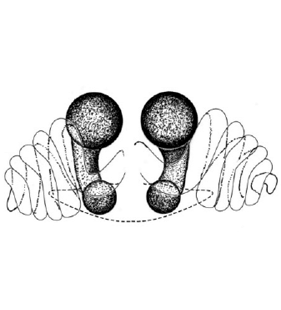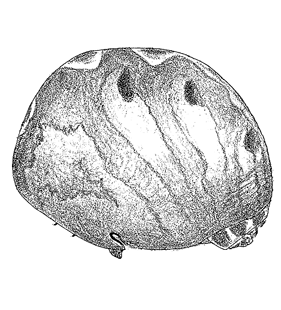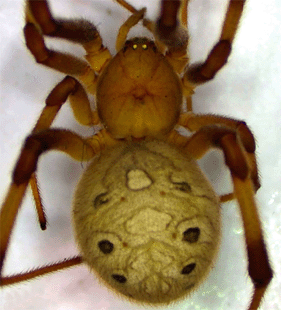Latrodectus geometricus C. L. Koch, 1841
Beschreibung
Männchen
Pedipalpus ähnlich wie bei L. tredecimguttatus. Prosoma 2.4 mm lang. Färbung wie bei Weibchen, jedoch mit mehr Kontrast.
Körperlänge Männchen: 3.4-6.2 mmWeibchen
Vulva: Kopulationsgänge mit 4 Windungen, Spermatheken parallel. Prosoma braun, 4.4 mm lang. Beine: Patella und Spitze der Tibia dunkler. Opisthosoma dunkelbraun bis schwarz, dorsal mit schlingenförmigen, braunen Flecken, ventral mit einer dunkelroten Markierung. Opisthosoma mit sehr langen, haarartigen Borsten besetzt.
Körperlänge Weibchen: 8.1-13 mmZusätzliche Informationen
Normalerweise um Häuser, unter oder zwischen Steinen oder auf tiefer Vegetation. Höhenlage bis 1050 m.
Diese Art gilt als etwas weniger giftig als die europäische Art L. tredecimguttatus, sie kann aber Menschen beißen, genauso wie alle anderen Latrodectus-Arten außerhalb von Europa. Ein Biss hat oft starke Auswirkungen und verursacht in zwei Drittel aller Fälle starke und lang anhaltende Schmerzen, die in einem Drittel der Fälle die Gebissenen sogar vom Schlaf abhalten. In mehr als der Hälfte der Fälle nimmt die Schmerzintensität im Verlauf der ersten Stunde zu und strahlt auch in die Extremitäten und den Unterleib aus. Typische Symptome beinhalten Schweißausbrüche in 70% aller Fälle und weitere systemische Effekte in 20-30 % der Fälle (Übelkeit, Erbrechen in weniger als 20 % der Fälle, erhöhte Temperatur und neuromuskuläre Effekte in 10 %, Bluthochdruck in weniger als 10 % der Fälle). Die Schmerzen dauern 1-2 Tage und die übrigen Symptome 1-4 Tage. Bei Bedarf ist eine symptomatische Therapie empfohlen.
Diese Art stammt aus Afrika und ist daher nicht einheimisch im geografischen Europa. Einschleppungen in verschiedene Länder führten nicht zu etablierten Populationen, es gibt aber Nachweise aus der Türkei, Zypern und Nordafrika.
Verbreitung
Abbildungen
Verbreitungsnachweise
"No reference" bedeutet nicht, dass die Art in diesem Land nicht vorkommt, sondern dass wir die Referenz hierfür noch nicht eingefügt haben. Wir arbeiten daran.
Literatur
Abdel-Ghani D M A, Hassan F M, Sallam G M E (2023) Spiders as a bio-agent factor in a mango greenhouse at Giza Governorate, Egypt. Serket 20: 26-38 ![]()
Baert L, Maelfait J-P, Desender K, Hendrickx F, Dekoninck W, Berthet M, Bouckaert K, Caudron J, Leclercq M (2023) Updated checklist, origin, distribution, literature and genital drawings of the spiders of the Galápagos Islands Belgian Journal of Entomology 142: 1-188 ![]()
Bosmans R, Van Keer J, Russell-Smith A, Hadjiconstantis M, Komnenov M, Bosselaers J, Huber S, McCowan D, Snazell R, Decae A, Zoumides C, Kielhorn K-H, Oger P (2019c) Spiders of Cyprus (Araneae). A catalogue of all currently known species from Cyprus. Newsletter of the Belgian Arachnological Society 34, Suppl. 1: 1-173 ![]()
Bosmans R, Van Keer K (2017) Een herziene soortenlijst van de Belgische spinnen (Araneae). Nieuwsbrief van de Belgische Arachnologische Vereniging 32: 39-69 ![]()
Bosmans R. (unpubl.) Provisional list of spiders of North Africa. Database excerpt Aug. 2019
Danışman T, Kunt K B, Özkütük R S, Coşar İ (2024a) The checklist of the spiders of Turkey. Version 2024 [last updated 01 January 2024], online at http://www.spidersofturkey.info ![]()
El-Hennawy H K (2017a) A list of Egyptian spiders (revised in 2017). Serket 15: 167-183 ![]()
Knoflach B, Harten A van (2002) The genus Latrodectus (Araneae: Theridiidae) from mainland Yemen, the Socotra Archipelago and adjacent countries. Fauna of Arabia 19: 321-361 ![]()
Levy G (1998b) Araneae: Theridiidae. In Fauna Palaestina, Arachnida III. Israel Academy of Sciences and Humanities, Jerusalem. , 228 pp. ![]()
Murcia-Moreno D, Gálvez D (2025) Introduced spiders in Panama: species distributions and new records. Biology 14(4): 1-17 ![]()
Nolan M (2012b) A button in a balafon; an occurrence of the widow spider Latrodectus geometricus C. L. Koch (Araneae, Theridiidae) in Ireland. Newsletter of the British Arachnological Society 124: 6-7 ![]()
Noordijk J (2016) Nieuwe vondsten van weduwen Latrodectus in Nederland (Araneae: Theridiidae). Nederlandse Faunistische Mededelingen 47: 17-26 ![]()
Rozwałka R, Dawidowicz Ł, Wawer W (2017b) Three alien spider species (Araneae: Theridiidae) newly found in Poland. Fragmenta Faunistica 60: 61-66 ![]()
WSC (2025) World Spider Catalog. Version 26. Natural History Museum Bern, online at http://wsc.nmbe.ch (28.2.2025) doi: 10.24436/2 ![]()
Updates
| 24-01-2025 | Image insert | |
| 23-01-2025 | Image insert | |
| 22-04-2024 | Image insert | |
| 22-04-2024 | Distribution update | Detail |
| 01-03-2023 | Distribution update | Detail |
| 18-02-2022 | Distribution insert | Detail |
| 29-04-2021 | Distribution update | Detail |
| 03-11-2020 | Gallery image insert | |
| 09-06-2020 | Distribution update | Detail |
| 07-11-2019 | Distribution update | Detail |
| 21-11-2017 | Image insert | |
| 18-11-2017 | Distribution update | Detail |
| 04-06-2013 | Image insert |
